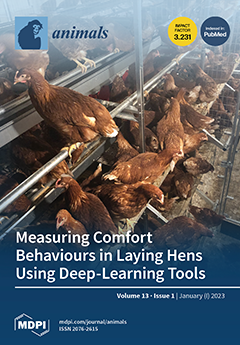The objective of this study was to evaluate the effect of feeding system on muscle fiber composition, antioxidant capacity, and nutritional and organoleptic traits of goat meat. Goats that grazed on flatland (whole area with about 0% inclination, FG group) and mountain range (whole area with about 40% inclination, MG group) were selected for the analysis. The results showed that grazing on flatland increased oxidized-twitch fiber percentage, the expression of the MyHC IIa gene (
p < 0.001), the activity of glutathione peroxidase (GSH-Px) (
p < 0.05), total antioxidant capacity (T-AOC) (
p = 0.001), and radical scavenging ability (RSA) (
p < 0.05); meanwhile, the MyHC IIb gene expression (
p < 0.01) and malondialdehyde (MDA) content (
p = 0.001) were decreased. Feeding system affected nutritional and organoleptic traits of goat meat, and grazing on flatland increased protein content, total content of monounsaturated fatty acid (MUFA), polyunsaturated fatty acid (PUFA), pH
45min, a* value, and variety of volatile flavor compounds but decreased the content of saturated fatty acid (SFA), shear force, and b* value. In addition, the key flavor substances were screened using relative odor activity value (ROAV), including hexanal, heptanal, (E)-2-octenal, octanal, nonanal, decanal, (E)-2-nonenal, and 1-octen-3-ol. Among them, 1-octen-3-ol and (E)-2-nonenal were the most contributing flavor compounds in the FG and MG groups, respectively, providing distinctive odor to goat meat.
Full article






